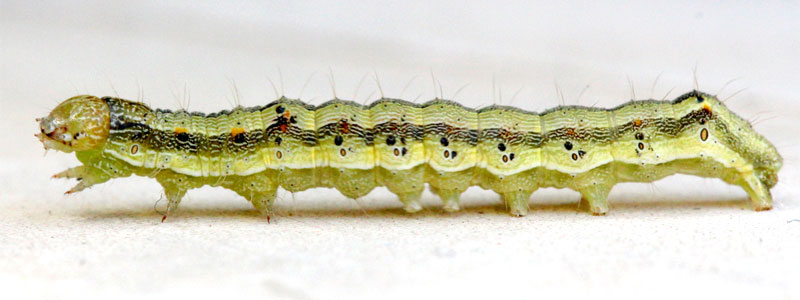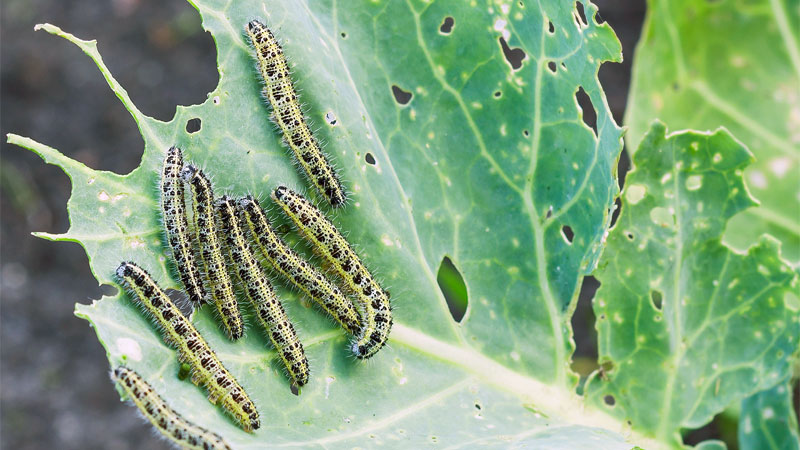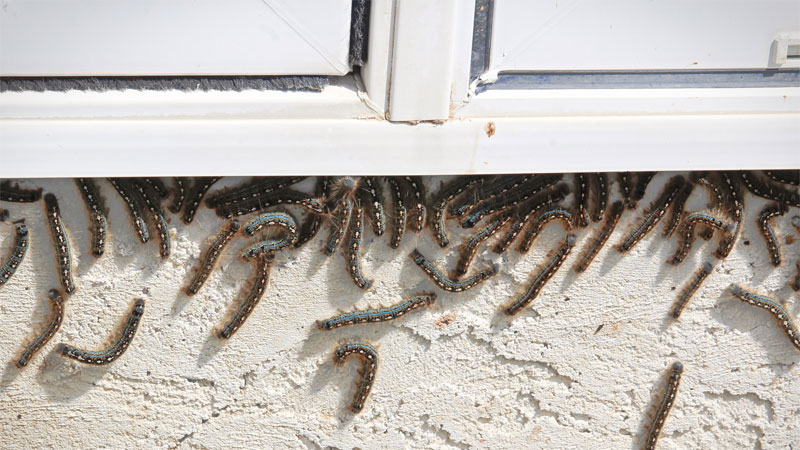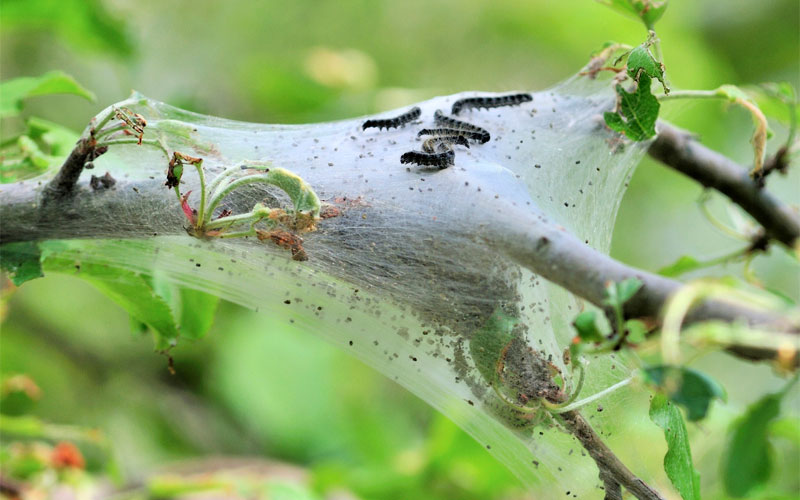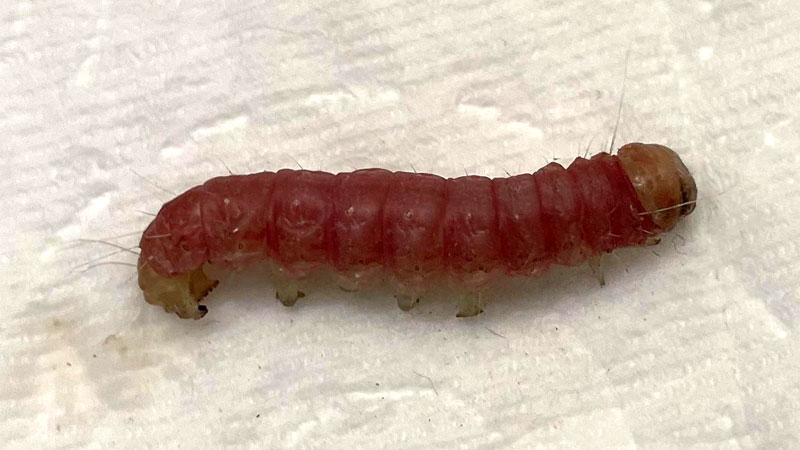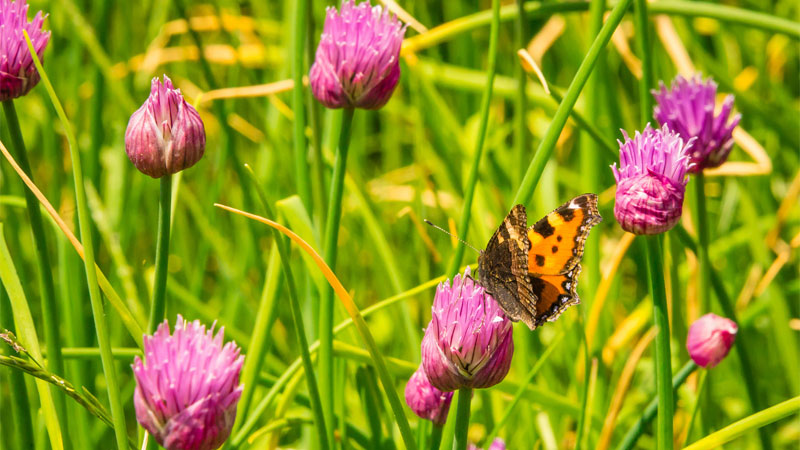There are plenty of creepy crawlies out there in the insect world, but one in particular can be a far bigger nuisance than you might think.
Moths and butterflies have a common larval stage in caterpillars, despite their other stages being different. These little critters can be cute and fluffy, but most are pests that will invade not only your garden but your home as well.
Let’s take a moment to unmask these tiny foes and discuss how to get rid of caterpillars before they can wreak havoc.
Getting to Know Caterpillars
While everyone knows caterpillars happen in gardens, they can actually be quite common in the home as well. Since they have such varied appearances, these baby moths and butterflies can live under a number of aliases.
Most species tend to appear in late summer to early fall, but some common indoor caterpillars can appear all year round. These little critters can do a lot of damage if left alone, so it’s important to address them quickly.
The Basics on Caterpillars
As mentioned, the larval stages for both moths and butterflies are officially called caterpillars, dispite the pupal and adult stages having different names.
Caterpillars can be found in many different sizes and colors, although all of them have the same basic body structure. This consists of a head, a worm-like body, six stubby legs in the front, and six false legs at the rear.
There are two major methods of locomotion for caterpillars: the worm-like compression and stretching or drawing the back in without contracting, causing the central part of the body to form a vertical loop (such as with inchworms).
With over 180,000 different caterpillar species out there, it’s a wonder they’re not a bigger problem than they are. Another important thing to note is that butterfly caterpillars rarely venture indoors, while moth caterpillars more commonly do.
The Many Names for Caterpillars
The larvae stage of the moth life cycle can have a wide range of nicknames connected to certain behaviors. Unfortunately, these names can make it easy to forget when you’re dealing with a caterpillar and not some other critter.
Here are some of the common nicknames you’ll encounter:
- Bookworm – moth larvae that feed on the wood pulp of books
- Cutworm – subterranean caterpillars which cut through tender seedlings
- Hornworm – caterpillars with small hornlike structures
- Inchworm and Looper – larvae, usually of moths, that pull their rear in without compressing, resulting in a loop shape; they’re often only about an inch long when they stretch out again.
- Mealworm – moth larvae usually found in opened boxes eating grain-based foods such as cereal or rice
- Silkworm – tree-dwelling caterpillars that create webbing, which was traditionally used to make silk
- Tent Caterpillar – caterpillars that live in trees and create tent-like webbing
Of course, many other names are often associated with a specific species (ex: armyworms). The important part is knowing that these pests have similar weaknesses.
Beware the Nasty Caterpillars
While some caterpillars look cute and cuddly and others look like tiny worms, there are a few that are actually somewhat dangerous.
For example, asp caterpillars don’t just share their name with snakes; their furry spines are actually venomous. They’re also sometimes referred to as puss caterpillars.
Touching one with your bare hands can lead to severe skin irritation or even neurological damage. They come in a range of colors and have no natural enemies, so it’s best to use gloves if handling a caterpillar you don’t know.
What Do Caterpillars Eat?
Any child can answer this question instantly: Caterpillars are hungry, hungry critters that will eat all sorts of things until they get a tummy ache.
Okay, so that’s not quite true, but these little pests really do eat quite a range of things.
Caterpillars are mostly herbivores with a voracious appetite. They most commonly eat foliage but will also attack young seedlings, new tender growth on plants, flowers, and cereal grains. Some, such as bookworms and mealworms, will also attack processed plant matter.
One big problem is that caterpillars don’t just go after foliage on many crops. For example, the tomato hornworm will burrow through the fruits on your tomato plants, and cabbage loopers can decimate brassica greens, such as broccoli, cabbage, and lettuce.
Some of these little pests will even attack the flowers of plants, such as roses.
Mostly Herbivores?
You heard us right. There’s a bit of an exception to the rule, and it’s from the Geometridae family (where inchworms come from). More precisely, they’re members of a genus called Eupithecia hailing from the archipelago kingdom-turned-state of Hawai’i.
Unlike the rest of the genus, all but one species of Hawai’ian Eupithecia are actually predators!
These unusual hunters have raptor-like limbs they use to capture their prey – including invasive species. Sadly, these awesome critters aren’t yet available for import to mainland gardens, but one can hope.
Meanwhile, here’s a PBS video of a Eupithecia orichloris caterpillar on the hunt.
Why Am I Finding Caterpillars in My House?
There are a lot of ways for these critters to make their way indoors. This may involve entry points, such as under doors or open windows. Often, it’s the adult moth that gets inside, laying her eggs soon after.
Also, because caterpillar eggs are so small, it can be easy to bring an infested plant – say a vegetable or flower cutting – inside where the egg then hatches. Finally, some smaller moths like to take up residence indoors and can lay their eggs throughout the year.
What Do Caterpillars Do in Winter?
Indoors, they’ll simply go about its business without any idea what the season is. Outdoors, caterpillars will either turn to moths before winter hits or overwinter in their pupal form to emerge in the spring.
How to Get Rid of Caterpillars
There are literally dozens of ways to get rid of a caterpillar infestation, and we could probably write an entire book on them. However, here are some of the best remedies we know of, as well as where they can be used.
Universal Methods
Before we get into specifics, there are a few remedies that work great both indoors and out. These can be used against all types of caterpillars.
Bacillus Thuringiensis (Bt)
This beneficial bacteria lives in the soil and is harmless to humans, pets, and birds. However, when ingested by a caterpillar, it can destroy their stomach lining, causing them to stop eating and die win a few days.
Many commercial products use Bt, such as:
- Bonide Thuricide
- DiPel Pro
- Ferti-Lome DiPel Dust
- Garden Safe
- Monterey
- Safer Caterpillar Killer
- Southern Ag DiPel Dust
- Southern Ag Thuricide
- INSECT KILLER - This pest control is designed for use on caterpillars and worm...
- FOLIAGE PROTECTOR - This insecticide is designed for use on a variety of plants...
- SAFE FOR EARTHWORMS & BEES - When used as directed, Monterey B.t. has no effect...
While it’s not the most humane killer out there, we love Bt because you’re using a remedy designed by Mother Nature herself. These products are safe for use on garden vegetables and other produce as well as indoors. It doesn’t even harm aquatic life or beneficial insects!
The only caveat is that you need to apply Bt when caterpillars are present because the bacterial will die out if exposed to sunlight or rain.
A good rule of thumb is to apply it three times, with the second application being ten days after the first and the third 14 days after the second. Not only will this kill the caterpillars already present, but it can eliminate new larvae as they hatch.
Neem Oil
When used properly, neem oil is one of the safest insecticides out there and will even combat some fungal and bacterial infections. Unlike chemical pesticides, it doesn’t harm earthworms or beneficial nematodes and (when applied at dawn or dusk) won’t harm beneficial insects.
You can safely harvest produce 24 hours after an application, and it leaves behind no residue. The only real risk is that it can be somewhat toxic to some aquatic life and shouldn’t be used near water features. Be sure to test on a small portion of a plant before using in case that plant has an allergy or sensitivity to neem.
- 🌿【The PUREST Neem Oil on the Market!】- Plantonix Neem Bliss is freshly...
- 🌸【Super Concentrated Neem Oil】- Unlike other brands, our neem oil spray...
- 🌱【Organic Neem Seed Oil】- Neem Bliss is listed by the Organic Materials...
Soil Soaks
Neem soil soaks will work on both trees and smaller plants and function as a systemic insecticide that only affects chewing or piercing bugs (such as aphids or caterpillars). It uses raw neem oil mixed with water and is poured on the ground around the target plant’s roots.
The roots absorb the neem, which remains active for up to 22 days. It’s safe to reapply every 2 to 3 weeks as a preventative. When the pest tries to feed on the host plant, the need does all sorts of damage, such as making them forget to eat or causing infertility.
Neem Cakes
Neem cakes are the solids left over from extracting neem oil and make great fertilizers. While they don’t help against all caterpillars, they can kill grubs, cutworms, and other soil-based pests.
They can even help fight off root rot and other underground diseases to some extent, all while being totally harmless to beneficial critters.
Foliar Sprays
Finally, the neem foliar spray uses a clarified hydrophobic neem oil (a byproduct after the active ingredient Azardchtin is removed for use in chemical pesticides). It works as a contact killer by suffocating caterpillars and other pests.
It can be purchased commercially or mixed at home. The homemade version just requires some neem oil, warm water, a bit of liquid soap (to help with mixing) and a spray bottle. Easy peasy!
When applied at dusk or dawn, it won’t harm beneficial insects and dissipates without leaving residue in 45 minutes to an hour. It’s safe for use both indoors and in the garden, including as a spot treatment. Reapply every two weeks as a preventative.
Spinosad
Spinosad is a good alternative to Bt, but while it shares the same non-toxic nature, it also tends to be residual and can harm bees.
As it’s safe around humans and pets, it can be used indoors to attack caterpillars, mosquitoes, and flies. Outdoors, you need to be careful and use it in the late evening or night so bees won’t come in contact with it.
- Specially formulated to protect your vegetables, crops, lawns and outdoor...
- Uses a powerful combination of two active ingredients, it effectively controls...
- Effective against powdery mildew when it is sprayed directly on contact, plus a...
When ingested, the spinosad affects a caterpillar’s nervous system, paralyzing it and causing it to die in a day or two. It won’t harm any birds that come to munch on the immobile caterpillars.
In the Garden
Gardens and yards have both small and large plants, and many remedies are only effective with one or the other.
Among Vegetables or Flowers
One of the best ways to control a caterpillar invasion in the garden is to attract beneficial insects and natural predators. Birds, ladybugs, Asian lady beetles, parasitic wasps, and spiders all love a tasty caterpillar and will even help eliminate some other garden pests in the process.
Cyonara 9.7
Cyonara 9.7 is more than just a fun pun; it can be a useful insecticide for garden plants of all sizes. This insecticide targets caterpillars without harming plants and can even be used as a spot treatment around possible entry points.
Use it every 2 to 3 months as a preventative. The only downside is we don’t recommend using this treatment on edible plants, as it’s not safe for consumption like neem-treated plants are.
Pyrethrins
Pyrethrins can work against a wide range of bug infestations. They’re a natural insecticide extracted from chrysanthemums. A synthetic form called pyrethroids is also available. Both can be purchased as natural or chemical insecticides and work well against caterpillars and many other insect pests.
Soapy Water
Soapy water is another great way to deal with caterpillars. Simply get a bucket of soapy water, throw on some gloves (some species of caterpillar are toxic or can sting), then pluck each caterpillar off and drop them into the bucket to drown.
You can also prune off small branches or leaves which have a number of caterpillars and drop the whole thing in.
On Shrubs and Trees
It’s not as common to see caterpillars attack an established tree or large shrub, and they’re often not much of a threat. However, their feeding can have more severe consequences for younger shrubs and trees.
The good news is that you’ll often have help getting rid of these caterpillars, especially from birds and spiders. When that doesn’t work, neem soil soaks are a great way to go.
Other insecticides can also work, but as those who have tried to get rid of bagworms from trees have realized, treating a tree with contact insecticides is usually not worth the hours of effort.
Neem soil soaks are generally the best caterpillar killers for trees since insecticidal sprays can require hours of work to fully apply.
In the House
Dealing with caterpillars in the home is a little different because you can’t simply use a lot of pesticides. Instead, you may need to be a little sneakier.
When discovering mealworms, the easiest thing to do is to take the infested food outside and dispose of it. Bookworms can be killed with a touch of rubbing alcohol on a cotton swab (there are places you can take the damaged book for repair, no matter how old it is).
One issue with some caterpillars is that they can ooze, much like slugs and snails. If not washed off quickly, these trails can stain walls and other surfaces.
Essential oils are a great way to help discourage caterpillars and moths. Choose strong scents, such as peppermint, or use a chili or garlic-based spray to make cabinets and pantries unappealing. Pepper flakes and bay leaves are also said to work.
How to Keep Caterpillars Away
Prevention is often the best medicine, and it’s not so difficult to keep caterpillars away from your garden or home. In addition to regular neem treatments on your plants, there are a few quick-and-dirty methods for you can employ.
Butterfly Gardens
Sometimes the best way to get rid of a critter is to give it a sanctuary. Try planting a butterfly garden to draw their attention. As moths are closely related to butterflies, this trick will work on many moth species as well.
Remember, butterflies are also valuable pollinators, so by giving them a spot that’s preferable for laying eggs, you’re helping your garden in more ways than one. Some great choices for butterfly gardens include:
- Carrots
- Dill
- Fennel
- Lantana
- Milkweed
- Parsley
- Parsnips
- Queen Anne’s Lace
- Red Clover
- Thistle
- Verbena
Note that any of these plants the butterflies don’t devour can be later used for flower arrangements or food.
Complimentary Gardening
As you may know, we love natural remedies, and complimentary gardening (AKA companion planting) is one of the absolute best.
It involves adding in plants that are resistant to diseases or can repel unwanted critters with plants that attract beneficial critters and any flowers or crops you’re growing. As different plants have different root depths, you can sometimes plant these really close together.
For example, an old issue of Mother Earth News Almanac (a similar publication to the Old Farmer’s Almanac but focused on green living) explained how you can grow a loaf of bread on a single square acre of land without ever needing to maintain it by hand!
And that’s the true beauty of complimentary gardening. Some great plants to add to your garden (and especially with brassicas such as cabbage) are hyssop, lavender, mugwort, oregano, peppermint, sage, and thyme.
Alliums, such as garlic and ornamental onions, can also repel some species of caterpillar. The best part about using these plants is that they give back, either in the form of pretty flowers or as useful kitchen herbs.
Lighting
Avoid leaving outdoor lights on at night or having lights on in a room with an open window. This tends to be an open invitation for moths and may result in them laying eggs nearby.
Netting
Especially useful for produce gardens, row covers and fine mesh fabrics can prevent butterflies and moths from reaching your plants. They can also deter a number of other pests. Just keep in mind that the covers may also block pollinators.
Warning: Some Caterpillars Shouldn’t be Killed!
There are a few caterpillars out there that belong to endangered or rare species of butterfly and moth. The adults are often quite beautiful or even valuable pollinators.
For example, it’s believed that brugmansias (AKA angel’s trumpets) recently became extinct in the wild because their chief pollinator (a moth species) died out.
Some important species to look out for are the monarch butterfly and swallowtail butterfly, both of which are easily dealt with by keeping a butterfly garden.
When you find one of these two species in your ornamental or produce garden, simply pluck them off and take them to the butterfly area. Monarch caterpillars have black and yellow stripes, while swallowtails are bright green caterpillars with yellow and white stripes.
When in doubt, use a phone app such as Picture Insect (iOS or Android) to quickly identify the caterpillar you’re dealing with so you can research whether they’re a valuable plant ally, endangered, or a pest species.
- How to Get Rid of Hawks - March 8, 2024
- How to Get Rid of Pill Bugs (Rolly Pollies) - March 1, 2024
- How to Get Rid of Groundhogs (Woodchucks) - February 5, 2024

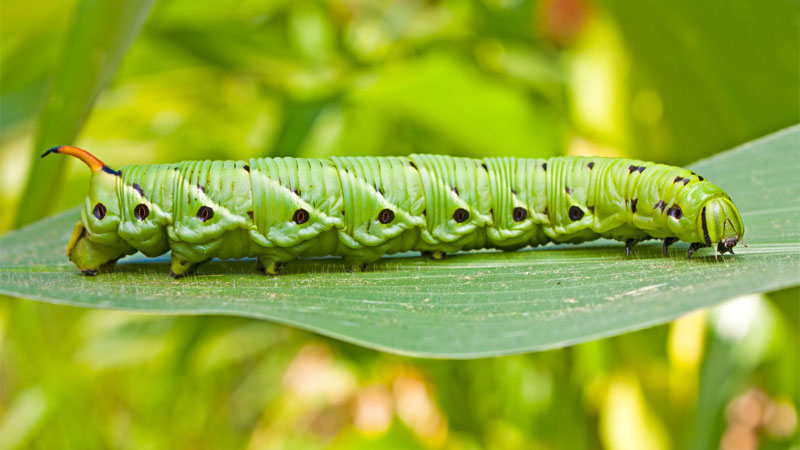
 Just tell me how to get rid of ’em.
Just tell me how to get rid of ’em.